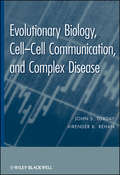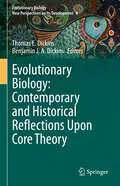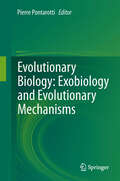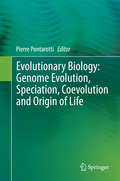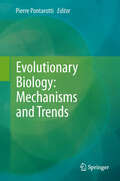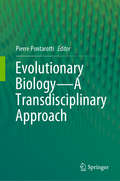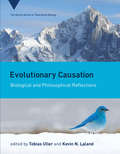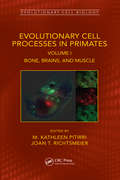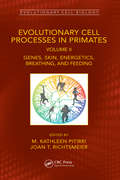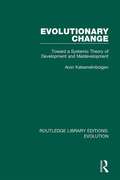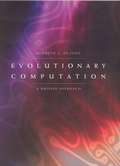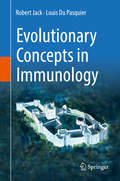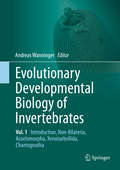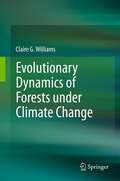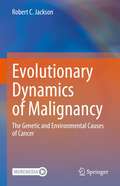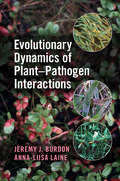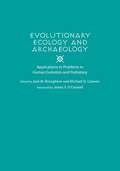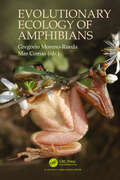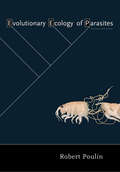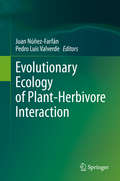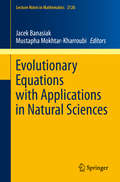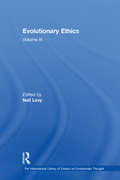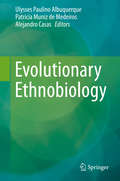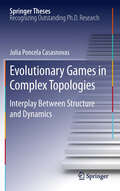- Table View
- List View
Evolutionary Biology: Cell-Cell Communication, and Complex Disease
by John S. Torday Virender K. RehanAn integrative view of the evolution of genetics and the natural world Even in this advanced age of genomics, the evolutionary process of unicellular and multicellular organisms is continually in debate. Evolutionary Biology, Cell–Cell Communication, and Complex Disease challenges current wisdom by using physiology to present an integrative view of the nature, origins, and evolution of fundamental biological systems. Providing a deeper understanding of the way genes relate to the traits of living organisms, this book offers useful information applying evolutionary biology, functional genomics, and cell communication studies to complex disease. Examining the 4.5 billion-year evolution process from environment adaptations to cell-cell communication to communication of genetic information for reproduction, Evolutionary Biology hones in on the "why and how" of evolution by uniquely focusing on the cell as the smallest unit of biologic structure and function. Based on empirically derived data rather than association studies, Evolutionary Biology covers: A model for forming testable hypotheses in complex disease studies The integrating role played by the evolution of metabolism, especially lipid metabolism The evolutionary continuum from development to homeostasis Regeneration and aging mediated by signaling molecules Ambitious and game-changing Evolutionary Biology suggests that biology began as a mechanism for reducing energy within the cell, defying the Second Law of Thermodynamics. An ideal text for those interested in forward thinking scientific study, the insights presented in Evolutionary Biology help practitioners effectively comprehend the evolutionary process.
Evolutionary Biology: Contemporary and Historical Reflections Upon Core Theory (Evolutionary Biology – New Perspectives on Its Development #6)
by Thomas E. Dickins Benjamin J. A. DickinsThis book is reflecting upon core theories in evolutionary biology – in a historical as well as contemporary context. It exposes the main areas of interest for discussion, but more importantly draws together hypotheses and future research directions. The Modern Synthesis (MS), sometimes referred to as Standard Evolutionary Theory (SET), in evolutionary biology has been well documented and discussed, but was also critically scrutinized over the last decade. Researchers from diverse disciplinary backgrounds have claimed that there is a need for an extension to that theory, and have called for an Extended Evolutionary Synthesis (EES). The book starts with an introductory chapter that summarizes the main points of the EES claim and indicates where those points receive treatment later in the book. This introduction to the subjects can either serve as an initiation for readers new to the debate, or as a guide for those looking to pursue particular lines of enquiry. The following chapters are organized around historical perspectives, theoretical and philosophical approaches and the use of specific biological models to inspect core ideas. Both empirical and theoretical contributions have been included. The majority of chapters are addressing various aspects of the EES position, and reflecting upon the MS. Some of the chapters take historical perspectives, analyzing various details of the MS and EES claims. Others offer theoretical and philosophical analyses of the debate, or take contemporary findings in biology and discuss those findings and their possible theoretical interpretations. All of the chapters draw upon actual biology to make their points. This book is written by practicing biologists and behavioral biologists, historians and philosophers - many of them working in interdisciplinary fields. It is a valuable resource for historians and philosophers of biology as well as for biologists. Chapters 8, 20, 22 and 33 are available open access under a Creative Commons Attribution 4.0 International License via link.springer.com.
Evolutionary Biology: Exobiology and Evolutionary Mechanisms
by Pierre PontarottiThis book presents 19 selected contributions to the 16th Evolutionary Biology Meeting, which took place in September 2012 in Marseilles. The aims of these annual meetings, which gather together leading evolutionary biologists and other scientists, are to promote the exchange of ideas and to encourage interdisciplinary collaborations. The first chapter deals with the history of a great discovery: The first experiments on ascidian and sea urchin egg fertilization. The remaining contributions are grouped under the following categories: · Evolutionary biology concepts · Exobiology and the origin of life · Evolutionary mechanisms Offering an up-to-date overview of recent findings in the field of evolutionary biology, this book is an invaluable source of information for scientists, teachers and advanced students.
Evolutionary Biology: Genome Evolution, Speciation, Coevolution and Origin of Life
by Pierre PontarottiThis book includes the most essential contributions presented at the 17th Evolutionary Biology Meeting in Marseille, which took place in September 2013. It consists of 18 chapters organized according to the following categories: · Molecular and Genome Evolution · Phylogeography of Speciation and Coevolution · Exobiology and Origin of Life The aims of the annual meetings in Marseille, which bring together leading evolutionary biologists and other scientists using evolutionary biology concepts, e. g. for medical research, are to promote the exchange of ideas and to encourage interdisciplinary collaborations. Offering an overview of the latest findings in the field of evolutionary biology, this book represents an invaluable source of information for scientists, teachers and advanced students.
Evolutionary Biology: Mechanisms and Trends
by Pierre PontarottiThe annual Evolutionary Biology Meetings in Marseilles serve to gather leading evolutionary biologists and other scientists using evolutionary biology concepts, e.g. for medical research. The aims of these meetings are to promote the exchange of ideas and to encourage interdisciplinary collaborations. This book collects 19 selected contributions presented at the 15th meeting, which took place in September 2011. It starts with a description of the life and work of J.B.S. Haldane, a remarkable evolutionary biologist of the 20th century. The remaining chapters are grouped under the following three themes: · New Concepts in Evolutionary Biology · Macroevolution: Mechanisms and Trends · Genome Evolution Offering an up-to-date overview of recent results in the field of evolutionary biology, this book is an invaluable source of information for scientists, teachers and advanced students.
Evolutionary Biology—A Transdisciplinary Approach
by Pierre PontarottiThis book includes 16 selected contributions presented at the 23rd Evolutionary Biology Meeting, which took place in Marseille in September 2019. The annual Evolutionary Biology Meetings in Marseille serve to gather leading evolutionary biologists and other scientists using evolutionary biology concepts, e.g. for medical research. The aim of these meetings is to promote the exchange of ideas to encourage interdisciplinary collaborations. Offering an up-to-date overview of recent findings in the field of evolutionary biology, this book is an invaluable source of information for scientists, teachers and advanced students.
Evolutionary Causation: Biological and Philosophical Reflections (Vienna Series in Theoretical Biology #23)
by Kevin N. Laland Tobias UllerA comprehensive treatment of the concept of causation in evolutionary biology that makes clear its central role in both historical and contemporary debates.Most scientific explanations are causal. This is certainly the case in evolutionary biology, which seeks to explain the diversity of life and the adaptive fit between organisms and their surroundings. The nature of causation in evolutionary biology, however, is contentious. How causation is understood shapes the structure of evolutionary theory, and historical and contemporary debates in evolutionary biology have revolved around the nature of causation. Despite its centrality, and differing views on the subject, the major conceptual issues regarding the nature of causation in evolutionary biology are rarely addressed. This volume fills the gap, bringing together biologists and philosophers to offer a comprehensive, interdisciplinary treatment of evolutionary causation.Contributors first address biological motivations for rethinking evolutionary causation, considering the ways in which development, extra-genetic inheritance, and niche construction challenge notions of cause and process in evolution, and describing how alternative representations of evolutionary causation can shed light on a range of evolutionary problems. Contributors then analyze evolutionary causation from a philosophical perspective, considering such topics as causal entanglement, the commingling of organism and environment, and the relationship between causation and information.ContributorsJohn A. Baker, Lynn Chiu, David I. Dayan, Renée A. Duckworth, Marcus W Feldman, Susan A. Foster, Melissa A. Graham, Heikki Helanterä, Kevin N. Laland, Armin P. Moczek, John Odling-Smee, Jun Otsuka, Massimo Pigliucci, Arnaud Pocheville, Arlin Stoltzfus, Karola Stotz, Sonia E. Sultan, Christoph Thies, Tobias Uller, Denis M. Walsh, Richard A. Watson
Evolutionary Cell Processes in Primates: Bone, Brains, and Muscle, Volume I (Evolutionary Cell Biology)
by M. Kathleen Pitirri Joan T. RichtsmeierMany complex traits define the human condition, including encephalization and bipedalism. The specific molecular signals and cellular processes producing these traits are the result of dramatic evolutionary change. At the same time, conservation of many of these developmental programs underlie both structure and function. Novel methodologies and techniques allow analysis of the collective behavior of cells, cell shapes, tissues, and organs. This volume demonstrates the essential role of cellular mechanisms in the evolutionary increase in the size and complexity of the primate brain. In addition, and concordant with encephalization, this book documents changes in the muscles and bones associated with the appearance of bipedalism. Genetic changes are the basis of these evolutionary changes, but transformation of genetic information into phenotypic outcomes occurs at the level of the cell, and this is the focus of the book. The goal is to encourage others to adopt evolutionary cell biology as a novel and necessary approach to the genotype-phenotype map of the diversification of primates, human variation, and human evolution. The contributors to this book utilize advances in genetic analysis, visualization of cells and tissues, and the merging of evolutionary developmental biology with evolutionary cell biology to address questions central to understanding the human and primate evolution. Key Features Explores mechanisms underlying trait distribution, dispersal, variation, and evolution through the direct testing of hypotheses especially with respect to patterns of encephalization, certain sensory modalities, and growth and life history specializations. Documents the advantages for anthropologists to work at the level of cells focusing on how genes provide instructions for cells to make structure and how environmental influences affect the behavior of cells. Illustrates the role cell biology plays with respect to encephalization, neocortical expansion, variation in facial morphology, locomotion, and dexterity. Describes novel methodologies and techniques allowing analysis of how the collective behavior of cells shapes tissues and organs. Related Titles Ripamonti, U., ed. Induction of Bone Formation in Primates: The Transforming Growth Factor-beta 3 (ISBN 978-0-3673-7740-3). Gordon, M. S., et al., eds. Animal Locomotion: Physical Principles and Adaptations (ISBN 978-0-3676-5795-6) Bianchi, L. Developmental Neurobiology (ISBN 978-0-8153-4482-7)
Evolutionary Cell Processes in Primates: Genes, Skin, Energetics, Breathing, and Feeding, Volume II (Evolutionary Cell Biology)
by M. Kathleen Pitirri Joan T. RichtsmeierMany complex traits define the primate condition, including behaviors as fundamental as locomotion and traits as scrutinized as the dentition, and their study reveals dramatic evolutionary change across the primates. Genetic modifications are at the basis of these changes, but transformation of genetic information into phenotypes occurs at the level of the cell, which is the focus of this book. Contributors summarize novel methodologies to analyze the collective behavior of cells in forming tissues and organs influencing physiological functions and anatomical features that enable behaviors. Our goal is to review current knowledge and encourage others to adopt evolutionary cell biology to aid in deciphering the genotype-phenotype map that underlies the diversification of primates, human variation, and human evolution. The contributors to this book utilize advances in genetic analysis and visualization of cells and tissues and merge evolutionary developmental biology with evolutionary cell biology to address questions central to understanding human and primate evolution. Key Features Explores mechanisms underlying trait development, distribution, variation, and evolution, especially with respect to pigmentation, dental formulae, the skeleton, energetics, and temperature-related morphological variation Documents the advantages for anthropologists to work at the level of cells, focusing on how genes provide instructions for cells to make structure and how environment affects the behavior of cells Illustrates the role cell biology plays in pelage growth and pigmentation, facial morphology, melanin production in pigmentation, dental development and tooth loss, and energy expenditure Describes novel methodologies and techniques to analyze environment- and temperature-related influences on phenotypes Demonstrates how significant changes in life history occur at the level of the cell Related Titles Bianchi, L. Developmental Neurobiology (ISBN 978-0-8153-4482-7) King, G. R. Primate Behavior and Human Origins (ISBN 978-1-138-85317-1) Rhys Evans, P. H. The Waterside Ape: An Alternate Account of Human Evolution (ISBN 978-0-367-14548-4)
Evolutionary Change: Toward a Systemic Theory of Development and Maldevelopment (Routledge Library Editions: Evolution #5)
by Aron KatsenelinboigenOriginally published in 1997 Evolutionary Change addresses the somatic mechanism of change. Although astounding advances in molecular biology have opened up new engineering possibilities to shape our future in terms of "improving" the human species as well as eradicating all kinds of pathological characteristics of biological development, these possibilities pose potentially serious dangers. They arise primarily from the local nature of changes that are introduced and the impact of the environment on the overall development of the biological system. The book explores the biological mechanisms of change in their entirety – as they fit into the general dynamics of biological systems – and demonstrates the pitfalls of tackling change from a narrow perspective, using cancer as an example of certain pathological manifestations of these mechanisms of change.
Evolutionary Computation: A Unified Approach
by Kenneth A. de JongChoice Outstanding Academic Title, 2006. Evolutionary computation, the use of evolutionary systems as computational processes for solving complex problems, is a tool used by computer scientists and engineers who want to harness the power of evolution to build useful new artifacts, by biologists interested in developing and testing better models of natural evolutionary systems, and by artificial life scientists for designing and implementing new artificial evolutionary worlds. In this clear and comprehensive introduction to the field, Kenneth De Jong presents an integrated view of the state of the art in evolutionary computation. Although other books have described such particular areas of the field as genetic algorithms, genetic programming, evolution strategies, and evolutionary programming, Evolutionary Computation is noteworthy for considering these systems as specific instances of a more general class of evolutionary algorithms. This useful overview of a fragmented field is suitable for classroom use or as a reference for computer scientists and engineers.
Evolutionary Concepts in Immunology
by Robert Jack Louis Du PasquierImmunology is a nodal subject that links many areas of biology. It permeates the biosciences, and also plays crucial roles in diagnosis and therapy in areas of clinical medicine ranging from the control of infectious and autoimmune diseases to tumour therapy. Monoclonal antibodies and small molecule modulators of immunity are major factors in the pharmaceutical industry and now constitute a multi billion dollar business. Students in these diverse areas are frequently daunted by the complexity of immunology and the astonishing array of unusual mechanisms that go to make it up.Starting from Dobzhansky’s famous slogan, “Nothing in biology makes sense except in the light of evolution”, this book will serve to illuminate how evolutionary forces shaped immunity and thus provide an explanation for how many of its counter intuitive oddities arose. By doing so it will provide a conceptual framework on which students may organise the rapidly growing flood of immunological knowledge.
Evolutionary Developmental Biology of Invertebrates 3
by Andreas WanningerThis multi-author, six-volume work summarizes our current knowledge on the developmental biology of all major invertebrate animal phyla. The main aspects of cleavage, embryogenesis, organogenesis and gene expression are discussed in an evolutionary framework. Each chapter presents an in-depth yet concise overview of both classical and recent literature, supplemented by numerous color illustrations and micrographs of a given animal group. The largely taxon-based chapters are supplemented by essays on topical aspects relevant to modern-day EvoDevo research such as regeneration, embryos in the fossil record, homology in the age of genomics and the role of EvoDevo in the context of reconstructing evolutionary and phylogenetic scenarios. A list of open questions at the end of each chapter may serve as a source of inspiration for the next generation of EvoDevo scientists. Evolutionary Developmental Biology of Invertebrates is a must-have for any scientist, teacher or student interested in developmental and evolutionary biology as well as in general invertebrate zoology. This is the first of three volumes dedicated to animals that molt in the course of their lifecycle, the Ecdysozoa. It covers all non-hexapods and non-crustaceans, i. e. , the Cycloneuralia, Tardigrada, Onychophora, Chelicerata and Myriapoda. While the Nematoda and all other phyla are treated in their own chapters, the remaining cycloneuralians are presented jointly due to the dearth of available developmental data on its individual subclades.
Evolutionary Dynamics
by Martin A. NowakAt a time of unprecedented expansion in the life sciences, evolution is the one theory that transcends all of biology. Any observation of a living system must ultimately be interpreted in the context of its evolution. Evolutionary change is the consequence of mutation and natural selection, which are two concepts that can be described by mathematical equations. Evolutionary Dynamics is concerned with these equations of life. In this book, Martin A. Nowak draws on the languages of biology and mathematics to outline the mathematical principles according to which life evolves. His work introduces readers to the powerful yet simple laws that govern the evolution of living systems, no matter how complicated they might seem. Evolution has become a mathematical theory, Nowak suggests, and any idea of an evolutionary process or mechanism should be studied in the context of the mathematical equations of evolutionary dynamics. His book presents a range of analytical tools that can be used to this end: fitness landscapes, mutation matrices, genomic sequence space, random drift, quasispecies, replicators, the Prisonerâe(tm)s Dilemma, games in finite and infinite populations, evolutionary graph theory, games on grids, evolutionary kaleidoscopes, fractals, and spatial chaos. Nowak then shows how evolutionary dynamics applies to critical real-world problems, including the progression of viral diseases such as AIDS, the virulence of infectious agents, the unpredictable mutations that lead to cancer, the evolution of altruism, and even the evolution of human language. His book makes a clear and compelling case for understanding every living systemâe"and everything that arises as a consequence of living systemsâe"in terms of evolutionary dynamics.
Evolutionary Dynamics of Forests under Climate Change
by Claire G. WilliamsFocusing on the example of the Lost Pines forest of Texas, this book contextualises the present-day conservation of the Lost Pines within its wealth of historical and geological records. This in turn presents a realistic example for examining evolutionary dynamics models and how they can guide management of temperate pine forests under the uncertainty of future climate change. Synthesising knowledge from many scholarly disciplines, and presenting the latest knowledge on how temperate forests respond to climate change, the book provides insight into how resource professionals actually solve complex multi-layered problems. A useful aid for forest management professionals and for advanced students and professionals in ecology, the book is a valuable resource for researchers and professionals, which can also be used as a classroom exercise for spatial imaging, testing virtual simulations and developing field-based research questions.
Evolutionary Dynamics of Malignancy: The Genetic and Environmental Causes of Cancer
by Robert C. JacksonAdvances in cancer genomics are transforming our understanding of cancer, and have profound implications for its prevention, diagnosis, and treatment. Evolutionary dynamics suggests that as few as two mutations can cause transformation of normal cells into cancer stem cells. A process of Darwinian selection, involving a further three or more mutations, taking place over a period of years, can then result in progression to a life-threatening tumour. In many cases the immune response can recognise and eliminate the mutant cells, but most advanced tumours have mutations that activate immune checkpoints and enable the tumour to hide from the immune system. For the most hard-to-treat tumours, future progress will require molecular diagnostics to detect cancer-causing mutations in healthy subjects, and new drugs or vaccines that prevent the progression process. Chapters of this book deal with the signalling pathways that control cell division, and changes in these pathways in cancer cells. Three cell cycle checkpoints that are often mutated in cancer are analysed in detail. A discussion of chronic myeloid leukaemia illustrates the role of reactive oxygen species in driving progression from a chronic to an acute condition. A single drug that suppresses reactive oxygen can prevent disease progression and turn an otherwise deadly disease into a condition that can be managed to enable many years of normal life. Another chapter discusses chronic myelomonocytic leukaemia, a disease that involves both genetic and epigenetic change. Tumour progression is discussed as a multi-stage process in which cancer stem cells evolve into genetically unstable, invasive, metastatic, drug-resistant growths. Each of these stages can act as targets for drugs or immunomodulators, but the future of cancer treatment lies in understanding tumour dynamics, and arresting malignancy at the earliest possible stage. Evolutionary dynamics is a primarily mathematical technique, but the target readership will be tumour biologists, clinicians, and drug developers. Computational detail is provided in an online supplement, but the main text emphasises the implications of the dynamics for an understanding of tumour biology and does not require mathematical expertise.
Evolutionary Dynamics of Plant-Pathogen Interactions
by Jeremy J. Burdon Anna-Liisa LaineThis volume sits at the cross-roads of a number of areas of scientific interest that, in the past, have largely kept themselves separate - agriculture, forestry, population genetics, ecology, conservation biology, genomics and the protection of plant genetic resources. Yet these areas also have a lot of common interests and increasingly these independent lines of inquiry are tending to coalesce into a more comprehensive view of the complexity of plant-pathogen associations and their ecological and evolutionary dynamics. This interdisciplinary source provides a comprehensive overview of this changing situation by identifying the role of pathogens in shaping plant populations, species and communities, tackling the issue of the increasing importance of invasive and newly emerging diseases and giving broader recognition to the fundamental importance of the influence of space and time (as manifest in the metapopulation concept) in driving epidemiological and co-evolutionary trajectories.
Evolutionary Ecology and Archaeology: Applications to Problems in Human Evolution and Prehistory
by Jack M Broughton Michael D CannonThe field of evolutionary ecology, which applies Darwinian natural selection theory to the study of adaptive design in behavior, morphology, and life history, has produced substantial advances in understanding human evolution and prehistory. Editors Jack Broughton and Michael Cannon have compiled archaeological and paleoanthro- pological studies that provide a foundation for sustained development of the study of the human past. Each of the twenty-four contributions represents a key benchmark in the field. Chapters are grouped by substantive topic and/or time period. Each of the following sections includes an introduction by the editors: • Early Hominid Evolution and Behavior • Pleistocene Foragers and Colonists • Post-Glacial Adaptations • Food Production Strategies • Cooperation and Competition in Complex Societies This volume’s broad range of research will foster sustained development of evolutionary ecology, and like Darwin’s work nearly 150 years ago will open wide fields of understanding of human prehistory.
Evolutionary Ecology of Amphibians
by Gregorio Moreno-Rueda Mar ComasAmphibians are the oldest tetrapod group and show an astonishing diversity in lifestyles, many of them being unique. However, globally, they are on a decline. Hence, their study is fundamental to understanding the evolution of diversity and conserving them. This book, authored by experts from around the world, summarizes the current knowledge on the evolutionary ecology of amphibians. The book treats biological concepts related to the evolution, ecology, physiology, immunology, behaviour, and morphology of amphibians in their different states. This book constitutes an actualized work indispensable for evolutionary ecologists and herpetologists.
Evolutionary Ecology of Parasites: Second Edition
by Robert PoulinParasites have evolved independently in numerous animal lineages, and they now make up a considerable proportion of the biodiversity of life. Not only do they impact humans and other animals in fundamental ways, but in recent years they have become a powerful model system for the study of ecology and evolution, with practical applications in disease prevention. Here, in a thoroughly revised and updated edition of his influential earlier work, Robert Poulin provides an evolutionary ecologist's view of the biology of parasites. He sets forth a comprehensive synthesis of parasite evolutionary ecology, integrating information across scales from the features of individual parasites to the dynamics of parasite populations and the structuring of parasite communities. Evolutionary Ecology of Parasites presents an evolutionary framework for the study of parasite biology, combining theory with empirical examples for a broader understanding of why parasites are as they are and do what they do. An up-to-date synthesis of the field, the book is an ideal teaching tool for advanced courses on the subject. Pointing toward promising directions and setting a research agenda, it will also be an invaluable reference for researchers who seek to extend our knowledge of parasite ecology and evolution.
Evolutionary Ecology of Plant-Herbivore Interaction
by Juan Núñez-Farfán Pedro Luis ValverdePlant-herbivore interactions are a central topic in evolutionary ecology. Historically, their study has been a cornerstone for coevolutionary theory. Starting from classic ecological studies at the phenotypic level, it has since expanded to molecular and genomic approaches. After a historical perspective, the book’s subsequent chapters cover a wide range of topics: from populations to ecosystems; plant- and herbivore-focused studies; in natural and in man-modified ecosystems; and both micro- and macro-evolutionary levels. All chapters include valuable background information and empirical evidence. Given its scope, the book will be of interest to both students and researchers, and will hopefully stimulate further research in this exciting field of evolutionary biology.
Evolutionary Equations with Applications in Natural Sciences
by Jacek Banasiak Mustapha Mokhtar-KharroubiWith the unifying theme of abstract evolutionary equations, both linear and nonlinear, in a complex environment, the book presents a multidisciplinary blend of topics, spanning the fields of theoretical and applied functional analysis, partial differential equations, probability theory and numerical analysis applied to various models coming from theoretical physics, biology, engineering and complexity theory. Truly unique features of the book are: the first simultaneous presentation of two complementary approaches to fragmentation and coagulation problems, by weak compactness methods and by using semigroup techniques, comprehensive exposition of probabilistic methods of analysis of long term dynamics of dynamical systems, semigroup analysis of biological problems and cutting edge pattern formation theory. The book will appeal to postgraduate students and researchers specializing in applications of mathematics to problems arising in natural sciences and engineering.
Evolutionary Ethics: Volume III (The International Library of Essays on Evolutionary Thought)
by Neil LevyMight human morality be a product of evolution? An increasing number of philosophers and scientists believe that moral judgment and behaviour emerged because it enhanced the fitness of our distant ancestors. This volume collects some recent explorations of the evidence for this claim, as well as papers examining its implications. Is an evolved morality a genuine morality? Does an evolutionary origin deflate the pretensions of morality, or strip it of its force in guiding behaviour? Is an evolutionary approach compatible with realism about morality? All sides of these debates are represented in this volume.
Evolutionary Ethnobiology
by Ulysses Paulino Albuquerque Patrícia Muniz De Medeiros Alejandro CasasEthnobiology is a fascinating science. To understand this vocation it needs to be studied under an evolutionary point of view that is very strong and significant, although this aspect is often poorly approached in the literature. This is the first book to compile and discuss information about evolutionary ethnobiology in English.
Evolutionary Games in Complex Topologies
by Julia Poncela CasasnovasThere are many examples of cooperation in Nature: cells cooperate to form tissues, organs cooperate to form living organisms, and individuals cooperate to raise their offspring or to hunt. However, why cooperation emerges and survives in hostile environments, when defecting would be a much more profitable short-term strategy, is a question that still remains open. During the past few years, several explanations have been proposed, including kin and group selection, punishment and reputation mechanisms, or network reciprocity. This last one will be the center of the present study. The thesis explores the interface between the underlying structure of a given population and the outcome of the cooperative dynamics taking place on top of it, (namely, the Prisoner's Dilemma Game). The first part of this work analyzes the case of a static system, where the pattern of connections is fixed, so it does not evolve over time. The second part develops two models for growing topologies, where the growth and the dynamics are entangled.
